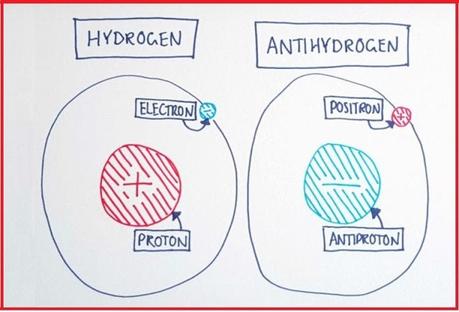However, the point of those demonstrations was that the audience could actually see what was going on and the results. The chances of being able to see an experiment to demonstrate anti-matter are remote to say the least. For instance, all the anti-protons that have been created at Fermilab’s Tevatron particle accelerator add up to only 15 nanograms. Those made at CERN amount to about 1 nanogram. At DESY in Germany, approximately 2 nanograms of positrons have been produced to date. But making a whole 1 gram of antimatter would require approximately 25 million billion kilowatt-hours of energy and cost over a million billion dollars.
Now comes the bit where some sort of explanation of antimatter must be attempted. Regular matter is made up of regular atoms. Regular atoms are composed of regular subatomic particles such as protons, neutrons, and electrons. Antimatter, on the other hand, is composed of subatomic particles that have the opposite charge and spin of regular subatomic particles. For example, anti-electrons, also known as positrons, behave just like electrons, except they have a positive charge. Likewise, antiprotons have a negative charge but act like protons.

Many scientists think that in the first few moments after the Big Bang, which created the universe both matter and antimatter mixed together. If the Big Bang made equal amounts of matter and antimatter, then the two would annihilate and become energy. There would be no matter and no antimatter left, just energy. But our universe today looks like it is almost all matter and hardly any antimatter.
Physicists do not yet know for sure that equal amounts of matter and antimatter were created, and because of this, they are also wondering where the antimatter went, and if any was left over from the beginning of the universe. One explanation is that there was just a bit more matter than antimatter in the beginning, so that whatever was left over after most of the matter and antimatter annihilated into energy became the mostly-matter universe we see today. Another theory is that there is lots of antimatter on the other side of the universe. They could have formed their own antigalaxies and antisolar systems too. I’m not going to mention that their time could go backwards or gravity could be up.
So why does antimatter matter? Faraday had no idea that his experiments would lead to high speed trains or the lights at Blackpool Football Club but fundamental research aims to understand the internal arrangement of nature and is not directly related to the present-day needs of civilization. So, it may sometimes look like a futile waste of time and money, with no tangible outcome. The benefits of fundamental research are usually revealed only after many years.
Electricity may have looked like a purposeless source of amusement to a few scientists just one hundred fifty years ago. Today, it has become a solid foundation of human civilization. It is likely that the study of antimatter will also produce such results, sooner or later; its outcome impossible to predict but whatever it is, it will be taxed.
I don’t have any poems about antimatter but here’s one about Physicists.
A Lecture on Quantum Mechanics
Remember the old joke
a vet goes into the waiting room
there’s good news
and bad news
Mr Schrodinger
Standing front and centre
he can watch polite chuckles
ripple along waves of Physicists
spreading out from the lectern
at the Conference Centre
he always starts like this
something predictable
to settle them down
but there’s a problem
with that one from CERN
second seat from the left
on the fifth row
who he knows is going to challenge
a line in his equations
he’d heard her say as much
over a gin and tonic
in Planck’s Bar last night
and now he’s only looking at
that one person
and even though she’s chuckling
along with her colleagues
he knows he’s affected his own talk
and wonders if it is ethical
to arrange for her
to be back in her hotel room
and here at the same time
which might solve his problem
but not with any certainty.
(First published in Acumen, 2017)
Thanks for reading, Terry.
Email ThisBlogThis!Share to TwitterShare to Facebook
